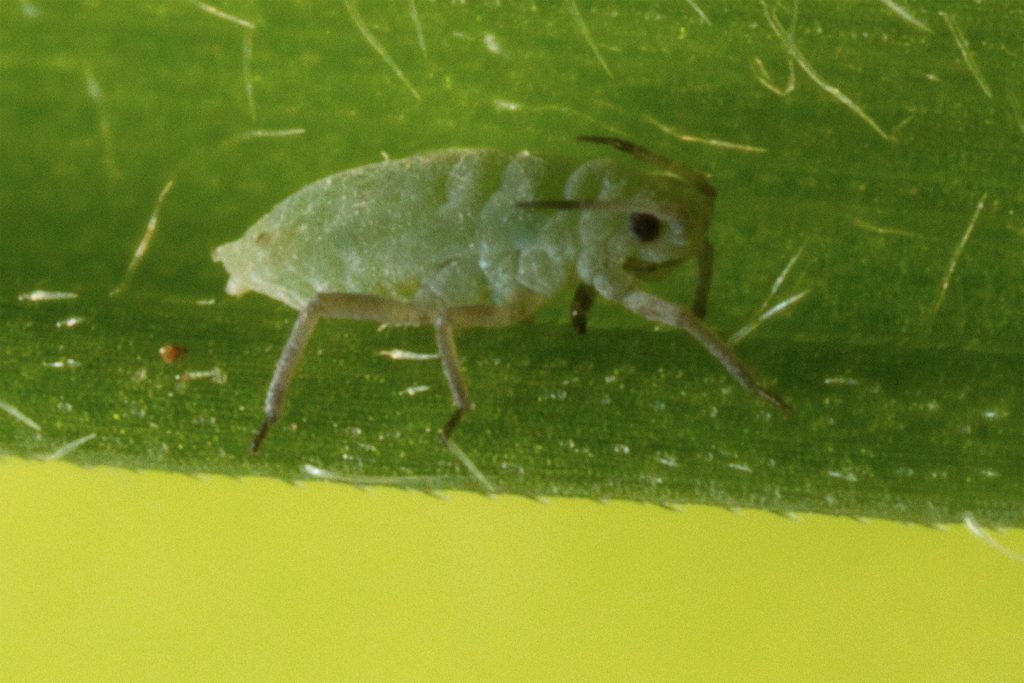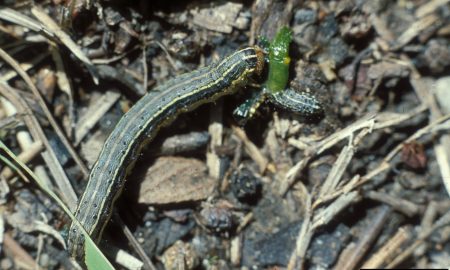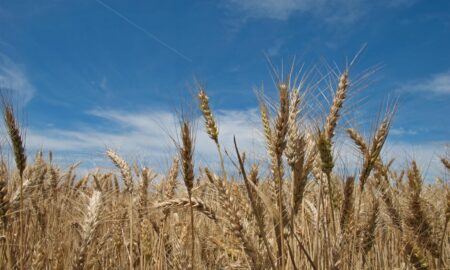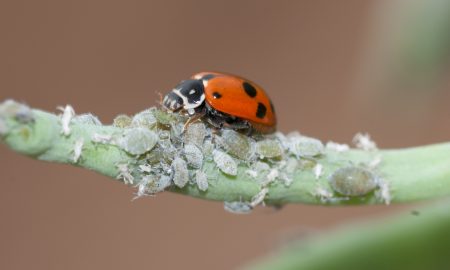Insecticide seed treatments are normally very effective at protecting emerging seedlings from early season pests such as aphids. However, we have received multiple reports of early establishment of Russian wheat aphid in seed treated crops recently.
In this article we detail recent reports and explore the conditions which might lead to less effective seed treatments.
Seed treatments to manage aphids
Insecticide seed treatments are widely used in Australia to reduce damage from pests in establishing cereal crops.
As well as protecting seeds from below ground insects, systemic treatments are taken up by the seedlings and moved into the germinating plant to protect against insect pests above ground.
The insecticide treatment on the seed is “released” into the soil when the seed comes in contact with moisture. The plant then takes up the chemical treatment via the root tips.
Seed treatments can be part of an effective management strategy for aphids and will typically provide more targeted and longer-term protection than foliar insecticide sprays. By protecting seedings at establishment, seed treatments can also reduce the need for sprays later in the season.
Insecticide seed treatments in cereal crops are neonicotinoids (Group 4A) or combinations of neonicotinoids and synthetic pyrethroids (Group 3A).
Duration of seed treatment protection
A study conducted by Cesar Australia in 2018 tested how long seed treatments were effective at keeping Russian wheat aphid (Diuraphis noxia) numbers low after crop emergence (wheat was used in the study).
The study found that all chemical treatments tested (Cruiser, Cruiser Opti and Gaucho) provided effective control of aphids for at least 5 weeks after wheat emergence. Some chemicals applied at a high rate were effective for up to 9 weeks.
Russian wheat aphid
Russian wheat aphids are distinguished by the slender, spindle shaped, pale green body. They have short antennae, an apparent lack of siphunculi and a distinctive cauda that looks like a ‘double tail’.
Further information on how to identify Russian wheat aphid can be found in our PestBites video and PestNote.
Earlier this year we predicted that Russian wheat aphid populations might be higher than normal in 2021 due to the persistence of green bridges over summer.

Reports of Russian wheat aphid in seed treated crops
There have been numerous reports of Russian wheat aphid in May and early June, and many people we spoke to noted that the aphids were present in crops that were sown with insecticide-treated seed. Moreover, there has been some concern that aphids were colonising cereal seedlings within only a matter of weeks post germination.
Reports from Forbes, Henty (NSW) and St Arnaud (Vic) all noted Russian wheat aphids early in the crop, but none had significant damage at this stage.
Three Russian wheat aphid samples have been sent to us for analysis and all had other aphid species present too. It is not uncommon to see multiple cereal aphids attacking the same crop. Often when a plant is damaged by an aphid or is under environmental stress such as water stress, multiple aphids will colonise the weakened plant.
The reports we have received suggest that Russian wheat aphid has become a problem earlier this year than in previous years. In 2019 they started appearing in August, and only in low numbers, most likely because of low population numbers in green bridge refuges and effective seed treatments.
Why seed treatments might be providing less effective control
Insecticide seed treatments are normally a highly effective control for Russian wheat aphid, even more so than for other aphid species in cereal crops.
There are several reasons that could explain the observations being reported this year.
Firstly, dry sowing conditions in many regions may have impacted the effectiveness of insecticide seed treatments. Some people reported cereal seed sitting in the ground for up to 6 weeks before germination. If a small amount of moisture was present after sowing this could be enough to release the insecticide into the soil (where it will begin to slowly breakdown) but not enough to stimulate germination.
Secondly, insecticide seed treatments may have been effective in the early stages of crop development, but aphids have since moved into the crop as the chemical has worn off.
There was a significant green bridge in many regions this year, meaning extensive refuge for Russian wheat aphid over summer. In some parts, this likely resulted in large populations of aphids during autumn.
Even if 98% of Russian wheat aphids were controlled by the use of insecticide seed treatments, if large numbers were still flying around there would be plenty of alive (but possibly sick) aphids in the crop.
Warm temperatures experienced during autumn would have facilitated the continual build up aphid populations and the development of winged individuals.
Thirdly, the warmer autumn weather means faster plant growth. As cereal plants get larger, the insecticide becomes more dilute (because there is greater plant mass), which means the length of protection offered by seed treatments is reduced.
Finally, the efficacy of seed treatments can be impacted by the quality of the application. If not all the seeds are coated during the application process this can result in some plants within the crop not receiving protection.
Management
Since large numbers of Russian wheat aphid have been detected in some regions regular monitoring is recommended. Easy to spot plant damage symptoms include white and purple longitudinal streaks on leaves as well as discoloured, stunted or curled leaves.

Our Russian wheat aphid threshold calculator is available to help decide if spraying is economically justified. This action threshold calculator considers dynamic factors including cost of control, cereal market price and aphid numbers.
The threshold calculator can be used between GS30 (start of stem elongation) and GS50 (start of head emergence), although monitoring is recommended at GS30 as early infestations of this aphid can prove the most impactful on potential yield.
If you are finding Russian wheat aphid in your crop prior to GS30, it is recommended you use the calculator and follow the rule of thumb of 2 times the calculated economic threshold value for higher yielding (>2 t/ha) environments. A higher economic threshold is recommended at earlier growth stages because in higher yielding environments (>2 t/ha) plants form many more tillers between GS20 and 30.
This means that at earlier growth stages, an economic threshold that is double that produced by the calculator should be followed – for example if at GS30 an action threshold of 5% of tillers with RWA present warrants control, then at earlier growth stages this action threshold doubles to 10% of tillers with RWA present.
At this early stage it is better to apply a “wait and see” approach, rather than applying an insecticide which will kill much of the beneficial population in the crop.
Russian wheat aphid is attacked by a range of natural enemies, including parasitoid wasps and generalist predators such as ladybird beetles, lacewings, damsel bug, hoverflies, and also entomopathogenic fungi.
If insecticides do need to be used, it is recommended that a softer option (such as pirimicarb) is tired first in order to preserve these beneficial species.
Acknowledgements
Thank you to the following advisors who contributed reports: Adam Pearce (Elders), Greg Toomey (NutrienAG), Tom Batters (DJPR), Nigel Clarke (Riverina co-op) and Greg Condon (Grassroots Agronomy).
Also, many thanks to Garry McDonald (UniMelb) and Paul Umina (Cesar Australia) for contributions to this article and to Ken McKee (Syngenta) for discussions on the action of seed treatments.
Cover image: Photo by Elia Pirtle, Cesar Australia





